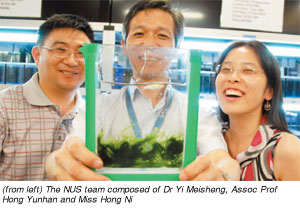 ome 8 years ago, semi-cloning was considered a scientific fiction and 26 years ago, using mice for the experiment, British scientist Sir Martin Evans attempted to make haploid embryonic stem (ES) cells. Fast-forward to 2009 and it is now a team led by Assoc Prof Hong Yunhan of the Department of Biological Sciences, who have successfully produced the world's first haploid embryonic stem cells and semi-cloned fish. Their work was published in the 16 October issue of the highly acclaimed Science magazine. ome 8 years ago, semi-cloning was considered a scientific fiction and 26 years ago, using mice for the experiment, British scientist Sir Martin Evans attempted to make haploid embryonic stem (ES) cells. Fast-forward to 2009 and it is now a team led by Assoc Prof Hong Yunhan of the Department of Biological Sciences, who have successfully produced the world's first haploid embryonic stem cells and semi-cloned fish. Their work was published in the 16 October issue of the highly acclaimed Science magazine.
"While traditional cloning uses a 'replacement' strategy, semi-cloning adopts a 'combination' strategy. In semi-cloning, scientists combine two haploid nuclei - one haploid nucleus from the embryonic stem cell mimicking the sperm nucleus, and the nucleus of an unfertilised egg (from the mother) - using nuclear transfer," said Assoc Prof Hong.
"In the practice of nuclear transfer for the production of Holly, we introduced a haploid embryonic stem cell nucleus into a mature egg. In this way, scientists mimic the reproduction process artificially, creating offspring that carry genetic traits from both parents similar to bisexual reproduction," he added.
For the study, the team worked the Medaka fish as it shares a number of genes with humans in the area of reproduction. The Medaka fish is also easy to maintain being small in size and producing 30 to 40 eggs a day. Experimenting with fish also ensured that there would be no ethical issues.
The findings of Assoc Prof Hong have important implications for reproductive medicine and technology. With semi-cloning which is 50 to 100 times more efficient than cloning, there is hope for the treatment of infertility, in particular male infertility which is more prominent.
 In addition, the NUS team's study has generated haploid embryonic stem cells which could be used to study the effect of recessive mutations of essential genes that may not be apparent in normal diploid cells. This spells the possibility of developing mammalian haploid embryonic stem cell cultures for disease analysis. In addition, the NUS team's study has generated haploid embryonic stem cells which could be used to study the effect of recessive mutations of essential genes that may not be apparent in normal diploid cells. This spells the possibility of developing mammalian haploid embryonic stem cell cultures for disease analysis.
Assoc Prof Hong said that the study using the fish model took some five years and a funding of SGD1.5 million to complete. This included time for consolidation of ideas, practical and administrative work. The next step would be to conduct the study on mice which will take approximately another five years. He is also currently looking for partners in Asia for collaboration.
 Click here to download the full issue for USD 6.50 Click here to download the full issue for USD 6.50
|


 ome 8 years ago, semi-cloning was considered a scientific fiction and 26 years ago, using mice for the experiment, British scientist Sir Martin Evans attempted to make haploid embryonic stem (ES) cells. Fast-forward to 2009 and it is now a team led by Assoc Prof Hong Yunhan of the Department of Biological Sciences, who have successfully produced the world's first haploid embryonic stem cells and semi-cloned fish. Their work was published in the 16 October issue of the highly acclaimed Science magazine.
ome 8 years ago, semi-cloning was considered a scientific fiction and 26 years ago, using mice for the experiment, British scientist Sir Martin Evans attempted to make haploid embryonic stem (ES) cells. Fast-forward to 2009 and it is now a team led by Assoc Prof Hong Yunhan of the Department of Biological Sciences, who have successfully produced the world's first haploid embryonic stem cells and semi-cloned fish. Their work was published in the 16 October issue of the highly acclaimed Science magazine.
 In addition, the NUS team's study has generated haploid embryonic stem cells which could be used to study the effect of recessive mutations of essential genes that may not be apparent in normal diploid cells. This spells the possibility of developing mammalian haploid embryonic stem cell cultures for disease analysis.
In addition, the NUS team's study has generated haploid embryonic stem cells which could be used to study the effect of recessive mutations of essential genes that may not be apparent in normal diploid cells. This spells the possibility of developing mammalian haploid embryonic stem cell cultures for disease analysis.
 Click here to download the full issue for USD 6.50
Click here to download the full issue for USD 6.50